Papers by Mario Delgado-Noguera
Revista Facultad Ciencis de la Salud universidad del Cauca, 2018
Recientemente se ha publicado un artículo de consenso importante para las labores del los editore... more Recientemente se ha publicado un artículo de consenso importante para las labores del los editores de revistas biomédicas (1). Como se sabe los editores juegan un papel central y clave en el proceso editorial de las revistas cuya función es diseminar los resultados de investigación en áreas de la salud. Sin embargo poco se conoce sobre las necesidades de formación de los editores para que de manera clara y transparente cumplan ese rol.
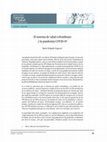
A mediados de abril de 2021, en el diario El Tiempo de Bogotá, Juan Gossain, el conocido periodis... more A mediados de abril de 2021, en el diario El Tiempo de Bogotá, Juan Gossain, el conocido periodista, entrevistó a Juan Carlos Giraldo, director de la Asociación Colombiana de Clínicas y Hospitales quien, como es conocido por amplios sectores de la salud, se quejó de las grandes deudas que las EPS (Empresas Promotoras de la Salud) tienen con los hospitales colombianos (1). Esporádicamente, en medio de la pandemia COVID-19, en los medios aparece la noticia de huelgas de los profesionales y de personal de salud de hospitales de todos los niveles a lo largo y ancho de la geografía nacional por la falta de pagos en sus salarios. Se quejan de deudas de varios meses. Esta clase de noticias en el país se tornan, desafortunadamente para la memoria colectiva, un lugar común, como lo que acontece con la muerte cotidiana de líderes sociales y varios factores que progresivamente se han acumulado hasta terminar en la crisis social, humanitaria y de gobernabilidad que atraviesa el país en el 2021.
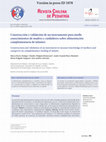
Construcción y validación de un instrumento para medir conocimientos de madres y cuidadores sobre alimentación complementaria de infantes, 2020
Resumen La nutrición adecuada durante los primeros dos años de vida es fundamental para el desarr... more Resumen La nutrición adecuada durante los primeros dos años de vida es fundamental para el desarrollo pleno del potencial del ser humano. La introducción inadecuada, precoz o tardía de la alimentación com-plementaria trae consecuencias a corto y largo plazo. La alimentación complementaria depende en gran medida de los conocimientos del cuidador que en los países de Latinoamérica generalmente es la madre. Objetivo: construir y validar un instrumento para medir los conocimientos maternos y de cuidadores sobre alimentación complementaria. Sujetos y Método: Estudio observacional. Partici-paron 80 madres comunitarias y 12 pediatras expertos. Se desarrolló en dos etapas: la creación del instrumento a partir de las 7 fases propuestas por Sampieri, y la validación mediante la evaluación de validez aparente, de constructo, de contenido, consistencia interna y fiabilidad intra-observador. ¿Qué se sabe del tema que trata este estudio? La alimentación complementaria se constituye como un elemento clave en el desarrollo intelectual, físico y emocional de los infantes. Los conocimientos de madres y cuidadores son determinantes en las prácticas de alimentación de los niños bajo su cuidado. ¿Qué aporta este estudio a lo ya conocido? Se presenta un instrumento rigurosamente construido y validado para medir conocimientos en alimentación complementaria a par-tir de lineamientos planteados por organizaciones líderes en la nu-trición infantil, y con mejor calidad metodológica que las versiones disponibles en la región.
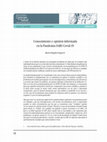
Revista Facultad Ciencias de la Salud Universidad del Cauca, 2020
A través de la historia humana los principales problemas de salud que los hombres han enfrentado ... more A través de la historia humana los principales problemas de salud que los hombres han enfrentado tienen que ver con la vida colectiva comunitaria (1). Para ilustrar esta afirmación viene al caso justamente lo que vivimos colectivamente con la pandemia por el COVID 19 SARS declarada por la OMS el 11 de marzo de 2020 (2). Al 4 de mayo de 2020 ya se contaban en el mundo más de 3 millones y medio de casos confirmados y 251.059 muertes (3). La epidemiología puede ser considerada como una ciencia básica para la salud pública, pero también es fundamental, por su naturaleza de aplicar el método científico a los problemas de la salud, para apoyar con sus investigaciones comunitarias a las decisiones y acciones que tomen los políticos, de quienes depende el bienestar de la población (1). Este es el caso de la actual pandemia por el COVID 19 SARS. Sin embargo, es el momento para que aquellos demuestren interés por comprender una teoría científica y fortalecer el juicio para escoger la mejor entre varias alternativas con un sano e informado escepticismo, pues la historia demuestra que esta actitud es preferible en la ciencia y en este caso de la pandemia, para preferir la evidencia sobre la opinión y los intereses sesgados (1) por un interés particular. Hay que tener en cuenta que algún hecho epidemiológico aplicado a la pandemia puede ser refutado y que las investigaciones y las teorías son dinámicas, pero es importante aceptar en estas circunstancias que las que se consideran como "verdades" pueden ser un asunto de opinión desde el poder. Tenemos el caso del presidente Donald Trump quien desde su "verdad", por ejemplo, ha quitado el apoyo económico a la OMS y de paso a su filial regional, la OPS, justo cuando más se necesitaba a este organismo que vela por la salud global para avanzar en el conocimiento, insuficiente e impreciso, de la pandemia y su agente causal (4). Un voz como la del presidente de Estados Unidos tiene una gran resonancia planetaria y muchos creerán que la OMS no informó adecuada ni oportunamente el peligro que representaba el virus.
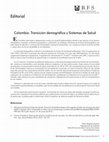
Revista Facultad de Salud USCO Vol 8. No 1, 2016
En Colombia cada región y departamento cuenta con un perfil epidemiológico distintivo que subyace... more En Colombia cada región y departamento cuenta con un perfil epidemiológico distintivo que subyace en los factores demográficos, culturales, económicos, geográficos y ambientales, sin embargo el fenómeno de la transición demográfica, que aflora desde los años 80´s, revela que las enfermedades crónicas no transmisibles son comunes en todo el territorio nacional y causan altos niveles de mortalidad en sus habitantes. La transición demográfica evidencia el estrechamiento de la base de la pirámide poblacional. Entre los quinquenios de 1985-1990 y 2010-2015 se presentó una reducción absoluta de 10 nacidos vivos por cada 1000 habitantes. En esta misma comparación temporal por quinquenios, la esperanza de vida aumentó en 7.22 años (1). Asimismo entre 2005, y la proyección a 2020, se observa que la tendencia de generalizada es el aumento de la población mayor de 55 años. En ese contexto, el aumento de población adulta mayor es directamente proporcional al incremento de las enfermeda-des crónicas no transmisibles como obesidad, diabetes, neoplasias y de tipo cardiovascular. Surge entonces la necesidad de preguntar si el actual modelo sistema de salud, enmarcado la Ley 100 de 1993, ofrece programas de prevención efectivos de las enfermedades crónicas no transmisibles de una población envejecida, así como la atención clínica de alta calidad requerida, pues por las características de dicho modelo, los servicios de salud son prestados por intermediarios o Empresas Prestadores de Servicios (EPS), quienes buscan siempre su propia sostenibilidad por encima de la calidad, de modo que la salud pasa a ser secundaria en el objeto de esta intermediación, regulada por la competencia en un esquema de mercado (2). Además, todos sabemos los graves problemas de corrupción y degradación de la atención que se derivan constantemente de este modelo. Entonces el panorama que se revela es poco alentador para nuestros adultos mayores, quienes buscan en el estado de enfermedad la oportunidad para ser atendidos, pues las necesidades de esta población no son prioridad del Sistema de Salud en Colombia. Por los argumentos anteriormente expuestos, las facultades de ciencias de salud están llamadas a proponer la reflexión, construcción y apropiación de políticas públicas que ayuden promover la atención digna y la calidad vida del adulto mayor, de manera que se pueda ayudar a contrarrestar, desde la academia, las falencias propias del Sistema de Salud.
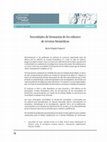
Revista de la facultad ciencias de la Salud. Universidad del Cauca, 2018
Recientemente se ha publicado un artículo de consenso importante para las labores de los editores... more Recientemente se ha publicado un artículo de consenso importante para las labores de los editores de revistas biomédicas (1). Como se sabe los editores juegan un papel central y clave en el proceso editorial de las revistas cuya función es diseminar los resultados de investigación en áreas de la salud. Sin embargo poco se conoce sobre las necesidades de formación de los editores para que de manera clara y transparente cumplan ese rol.
Por lo general no solamente en Colombia sino aun en el mundo desarrollado, se carece de una escuela formal de editores de revistas de ciencias de la salud (2). Aunque no tienen un entrenamiento formal, buena parte de ellos han sido profesores que se han formado en epidemiología, se han desempeñado como investigadores, han tenido a su cargo un grupo de investigación y han sido tutores. Un camino a veces incomprendido.
gQuemaduras en menores de cinco años en el Cauca: conocimientos, actitudes y prácticas.
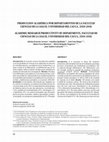
Abstract
Introduction: It is necessary to know the academic production of the Facultad Ciencias ... more Abstract
Introduction: It is necessary to know the academic production of the Facultad Ciencias de la Salud for generating processes of feed-back and institutional accreditation, this is achieved through bibliometrics. The bibliometrics uses the scientific method to quantify the academic production resultingof research process. Methods: Cross-sectional bibliometric investigation that used as population the whole scientific production represented in the published articles on journals (online and paper) in 2010 to 2016 in the Facultad de Ciencias de la Salud. Results: 183 articles were found to fulfill the inclusion criteria. The trend of the production decreasing since 2013. The departments of Medicine program were the ones with most contributions to the production (72%), followed by Fonoaudiology (10%), Physiotherapy (4%) and Nursery (2%). The main authors were men, doctors and specialists. The student’s entailment was found in 35%. Mainly, the articles were published in the Revista de la Facultad de Ciencias de la Salud (57%). The financing was observed only nly in one article. Conclusions: This study shows, for the first time, the bibliometric reality of our faculty. The university support is needed to continue with this labor that improves the planning and strengthens the academic quality.
Resumen
Introducción: Es necesario conocer la producción académica de las facultades de ciencias de la salud para los procesos de retroalimentación y acreditación de las instituciones esto se logra a través de la bibliometría. La bibliometría que en términos simples, utiliza el método científico para cuantificar la producción derivada de la investigación. Métodos: Investigación bibliométrica descriptiva de corte transversal que consideró como población toda la producción científica académica de la facultad representada en la publicación de artículos en revistas y publicaciones periódicas en el período 2010-2016. Resultados: Se encontraron 183 artículos que cumplían con los criterios de inclusión. La tendencia de producción fue decreciente desde el año 2013. Los departamentos del programa de Medicina fueron los que más aportaron a la producción (72%) seguidos por Fonoaudiología (10%), Fisioterapia (4%) y Enfermería (2%). Los autores principales más frecuentes fueron de género masculino, médicos especialistas y profesores de planta. La vinculación estudiantil fue de 35%. Principalmente se publicó en la Revista Facultad de Ciencias de la Salud (57%). La colaboración externa internacional para la publicación fue la más frecuente (38%). El financiamiento ocurrió solamente en un producto. Conclusiones: Este es un estudio que expone la realidad bibliométrica por primera vez en la Facultad Ciencias de la Salud. Es necesario el apoyo universitario en esta labor que favorece la planificación y que fortalece la calidad académica.
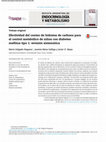
Carbohydrate counting as a therapeutic intervention in patients with Diabetes Mellitus type 1 (DM... more Carbohydrate counting as a therapeutic intervention in patients with Diabetes Mellitus type 1 (DM1) plays an important role in obtaining an optimal postprandial glucose level, which is demonstrated with the correct levels of glycosylated haemoglobin (HbA1c). However, recommendations for children with DM1 are based on narrative reviews of the available evidence. Our objective was to evaluate the effectiveness of carbohydrate counting on metabolic control of children with DM1. This study was a systematic review. The search was conducted in PubMed, Google Scholar, and controlled trials of the Cochrane collaboration (CENTRAL), published from January 2000 to September 2015. Five eligible trials out of 261 potentially relevant studies were identified, which include two trials. The quality of the studies was generally poor. The two studies included agreed on the positive impact of carbohydrate counting in reducing HbA1c levels as a measure of metabolic control. In general, the other parameters measured showed conflicting results with no significant differences, except for the high density lipoprotein in one study, higher in the intervention group. Although carbohydrate counting is a promising technique for metabolic control in children with type 1 diabetes, the evidence found in this review is not enough to recommend it.
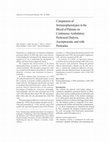
Peritonitis is a complication of continuous ambulatory peritoneal dialysis (CAPD) that often caus... more Peritonitis is a complication of continuous ambulatory peritoneal dialysis (CAPD) that often causes fibrosis. Understanding the role played by the immune system is required if we are to understand the mechanisms of defense and tissue lesion triggered by germs. We compared the characteristics of the blood immunophenotypes of patients on CAPD, with and without peritonitis. This descriptive, prospective study was carried out in the dialysis unit of San Jos University Hospital, a tertiary care institution in Popay n, Colombia. In blood samples from 46˚patients on CAPD (26˚with peritonitis and 20˚without peritonitis), we used flow cytometry to measure cytokine production at the single-cell level. The diagnosis of peritonitis was made by standard clinical and laboratory criteria. We noted general clinical characteristics of the patients; percentages of lymphocytes, monocytes, neutrophils, and eosinophils; and cell counts of lymphocytes (CD4 cells, CD8 cells) and their subsets [B1, B2, and natural killer (NK) cells]. We also determined the CD4:CD8 ratio. We found significant differences in the levels of serum albumin (p˚< 0.001), the percentages of lymphocytes (p˚< 0.04) and neutrophils (p˚< 0.04), and the counts of B1 and B2 cells, especially in patients whose CD4:CD8 ratio was below 1.2. Those patients also had more intense CD4 lymphopenia, more CD8 cells (principally T-suppressor cells), and more expansion of NK cells. In patients on CAPD, an important immune activation and rise in the percentage of B1 cells occurs that increases with peritonitis. Among the general clinical characteristics, albumin was the only one to show a statistically significant difference between patients with and without peritonitis. An important CD4 lymphopenia occurred in patients with a CD4:CD8 ratio below 1.2.
Burns are considered mostly as serious illness with devastating consequences and prolonged length... more Burns are considered mostly as serious illness with devastating consequences and prolonged length of hospital stay .

ciesas.edu.mx
Objetivo: Conocer los signos de peligro del recién nacido (RN) de hasta un mes de edad, consisten... more Objetivo: Conocer los signos de peligro del recién nacido (RN) de hasta un mes de edad, consistentes con las percepciones que los CP y TS tienen de tales signos y que los hacen buscar atención médica. Diseño: Triangulación de métodos cualitativos (Grupos focales (GF), entrevistas en profundidad) y cuantitativos (Entrevista estructurada). Lugar: Es un proyecto colaborativo de la red ChildNET de INCLEN (www.inclen.org). Se conduce un estudio en 9 sitios rurales de 8 países participantes. Estos sitios son: (1) Guapi, Colombia; (2) Fortaleza, Brazil; (3) Yaounde, Camerún; (4) Ismailia, Egipto; (5) Chennai, India; (6) Lucknow, India; (7) Jogyakarta, Indonesia; (8) Hidalgo, México; and (9) Calawis, Filipinas Participantes: Por área: 200 CP (madres, madres comunitarias, madres sustitutas, parteras) y 80% del total de los TS (promotores, auxiliares de enfermería, médicos generales, especialistas y médicos tradicionales).
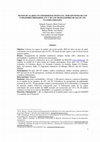
ciesas.edu.mx
Objetivo: Conocer los signos de peligro del recién nacido (RN) de hasta un mes de edad, consisten... more Objetivo: Conocer los signos de peligro del recién nacido (RN) de hasta un mes de edad, consistentes con las percepciones que los CP y TS tienen de tales signos y que los hacen buscar atención médica. Diseño: Triangulación de métodos cualitativos (Grupos focales (GF), entrevistas en profundidad) y cuantitativos (Entrevista estructurada). Lugar: Es un proyecto colaborativo de la red ChildNET de INCLEN (www.inclen.org). Se conduce un estudio en 9 sitios rurales de 8 países participantes. Estos sitios son: (1) Guapi, Colombia; (2) Fortaleza, Brazil; (3) Yaounde, Camerún; (4) Ismailia, Egipto; (5) Chennai, India; (6) Lucknow, India; (7) Jogyakarta, Indonesia; (8) Hidalgo, México; and (9) Calawis, Filipinas Participantes: Por área: 200 CP (madres, madres comunitarias, madres sustitutas, parteras) y 80% del total de los TS (promotores, auxiliares de enfermería, médicos generales, especialistas y médicos tradicionales).
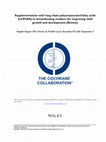
Supplementation with long chain polyunsaturated fatty acids (LCPUFA) to breastfeeding mothers for... more Supplementation with long chain polyunsaturated fatty acids (LCPUFA) to breastfeeding mothers for improving child growth and development.
Delgado-Noguera MF1, Calvache JA, Bonfill Cosp X, Kotanidou EP, Galli-Tsinopoulou A.
Author information
Abstract
BACKGROUND:
Long chain polyunsaturated fatty acids (LCPUFA), especially docosahexaenoic acid (DHA), are the most abundant fatty acids in the brain and are necessary for growth and maturation of an infant's brain and retina. LCPUFAs are named "essential" because they cannot be synthesised efficiently by the human body and come from maternal diet. It remains controversial whether LCPUFA supplementation to breastfeeding mothers is beneficial for the development of their infants.
OBJECTIVES:
To assess the effectiveness and safety of supplementation with LCPUFA in breastfeeding mothers in the cognitive and physical development of their infants as well as safety for the mother and infant.
SEARCH METHODS:
We searched the Cochrane Pregnancy and Childbirth Group's Trials Register (6 August 2014), CENTRAL (Cochrane Library 2014, Issue 8), PubMed (1966 to August 2014), EMBASE (1974 to August 2014), LILACS (1982 to August 2014), Google Scholar (August 2014) and reference lists of published narrative and systematic reviews.
SELECTION CRITERIA:
Randomised controlled trials or cluster-randomised controlled trials evaluating the effects of LCPUFA supplementation on breastfeeding mothers (including the pregnancy period) and their infants.
DATA COLLECTION AND ANALYSIS:
Two review authors independently assessed eligibility and trial quality, performed data extraction and evaluated data accuracy.
MAIN RESULTS:
We included eight randomised controlled trials involving 1567 women. All the studies were performed in high-income countries. The longest follow-up was seven years.We report the results from the longest follow-up time point from included studies. Overall, there was moderate quality evidence as assessed using the GRADE approach from these studies for the following outcomes measured beyond 24 months age of children: language development and child weight. There was low-quality evidence for the outcomes: Intelligence or solving problems ability, psychomotor development, child attention, and child visual acuity.We found no significant difference in children's neurodevelopment at long-term follow-up beyond 24 months: language development (standardised mean difference (SMD) -0.27, 95% confidence interval (CI) -0.56 to 0.02; two trials, 187 participants); intelligence or problem-solving ability (three trials, 238 participants; SMD 0.00, 95% CI -0.36 to 0.36); psychomotor development (SMD -0.11, 95% CI -0.48 to 0.26; one trial, 113 participants); motor development (SMD -0.23, 95% CI -0.60 to 0.14; one trial, 115 participants), or in general movements (risk ratio, RR, 1.12, 95% CI 0.58 to 2.14; one trial, 77 participants; at 12 weeks of life). However, child attention scores were better at five years of age in the group of children whose mothers had received supplementation with fatty acids (mean difference (MD) 4.70, 95% CI 1.30 to 8.10; one study, 110 participants)). In working memory and inhibitory control, we found no significant difference (MD -0.02 95% CI -0.07 to 0.03 one trial, 63 participants); the neurological optimality score did not present any difference (P value: 0.55).For child visual acuity, there was no significant difference (SMD 0.33, 95% CI -0.04 to 0.71; one trial, 111 participants).For growth, there were no significant differences in length (MD -0.39 cm, 95% CI -1.37 to 0.60; four trials, 441 participants), weight (MD 0.13 kg, 95% CI -0.49 to 0.74; four trials, 441 participants), and head circumference (MD 0.15 cm, 95% CI -0.27 to 0.58; three trials, 298 participants). Child fat mass and fat mass distribution did not differ between the intervention and control group (MD 2.10, 95% CI -0.48 to 4.68; one trial, 115 participants, MD -0.50, 95% CI -1.69 to 0.69; one trial, 165 participants, respectively).One study (117 infants) reported a significant difference in infant allergy at short-term follow-up (risk ratio (RR) 0.13, 95% CI 0.02 to 0.95), but not at medium-term follow-up (RR 0.52, 95% CI 0.17 to 1.59).We found no significant difference in two trials evaluating postpartum depression. Data were not possible to be pooled due to differences in the describing of the outcome. One study (89 women) did not find any significant difference between the LCPUFA supplementation and the control group at four weeks postpartum (MD 1.00, 95%CI -1.72 to 3.72).No adverse effects were reported.
AUTHORS' CONCLUSIONS:
Based on the available evidence, LCPUFA supplementation did not appear to improve children's neurodevelopment, visual acuity or growth. In child attention at five years of age, weak evidence was found (one study) favouring the supplementation. Currently, there is inconclusive evidence to support or refute the practice of giving LCPUFA supplementation to breastfeeding mothers in order to improve neurodevelopment or visual acuity.
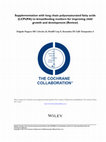
Background
Long chain polyunsaturated fatty acids (LCPUFA), especially docosahexaenoic acid (DHA)... more Background
Long chain polyunsaturated fatty acids (LCPUFA), especially docosahexaenoic acid (DHA), are the most abundant fatty acids in the brain and are necessary for growth and maturation of the brain and retina. LCPUFA are named “essential” because they cannot be synthesised efficiently by the human body and come from maternal diet. It remains controversial whether LCPUFA supplementation to breastfeeding mothers is beneficial for the development of their infants.
Objectives
To assess the effectiveness and safety of supplementation with LCPUFA in breastfeeding mothers in the cognitive and physical development of their infants as well as safety for the mother and infant.
Search strategy
We searched the Cochrane Pregnancy and Childbirth Group’s Trials Register (November 2009), CENTRAL (2009, Issue 2), PubMed (1966 to July 2009), EMBASE (1974 to June 2009), CINAHL (1984 to June 2009), LILACS (1982 to June 2009), Google Scholar (June 2009) and reference lists of published narrative and systematic reviews.
Selection criteria
Randomised controlled trials or cluster-randomised controlled trials evaluating the effects of LCPUFA supplementation on breastfeeding mothers and their infants.
Data collection and analysis
Two review authors independently assessed eligibility and trial quality and performed data extraction.
Main results
We included six randomised controlled trials involving 1280women.We found no significant difference in children’s neurodevelopment: language development (standardised mean difference (SMD) -0.14, 95% confidence interval (CI) -0.49 to 0.20; two trials, 349 participants); intelligence or problem-solving ability (two trials, 817 participants; SMD -0.22, 95% CI -0.23 to 0.66); psychomotor development (SMD 0.34, 95% CI -0.11 to 0.78; two trials, 279 participants); motor development (SMD 0.08, 95% CI -0.13 to 0.29; two trials, 349 participants); in child attention there was a significant difference (SMD 0.50, 95% CI 0.24 to 0.77; one study). For child visual acuity there was no significant difference (SMD -0.06, 95% CI -0.26 to 0.14; three trials, 401 participants). For growth, there were significant differences in length (MD -0.75 cm, 95% CI -1.38 to -0.12; two trials, 834 participants) and head circumference
(MD 0.69 cm, 95% CI 0.35 to 1.02; one trial, 244 participants). One study reported a significant difference in infant allergy (risk
ratio (RR) 0.12, 95% CI 0.02 to 0.95). We found no significant difference in one trial evaluating postpartum depression (SMD 0.15, 95% CI -0.11 to 0.41).
Authors’ conclusions
Based on the limited evidence that we found, LCPUFA supplementation did not appear to improve children’s neurodevelopment or visual acuity. In two studies, LCPUFA supplementation was associatedwith increased head circumference.Currently, there is insufficient
evidence to support or refute this supplementation.
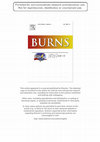
Objectives: To describe the epidemiological profile of minor and moderate burn victims at the Uni... more Objectives: To describe the epidemiological profile of minor and moderate burn victims at the University Hospital San Jose ́, Popaya ́n, Colombia, 2000–2010.
Methods: This study was retrospective description of minor and moderate burn victims admitted between 2000 and 2010 at the Burn Unit of University Hospital San Jose ́ (UHSJ). The following variables were recorded and analyzed: age, gender, origin, social security, depth and extent of burn, days of hospitalization, causal agent and mortality. SPSS 19.0 was used. The level of significance was p < 0.05.
Results: During 2000–2010, 845 patients were included. 61.7% were men. The average age was 17.9 years. Most of patients were from rural areas (80.4%). Most people belonged to the Subsidized Health Colombian System (85.3%). The most common causal agent was scalding liquids (49.7%). The most frequent depth was second degree burns (57.8%) and the average burned body surface was 20%. The average hospital stay was 20.4 days, and the median hospitalization time was 14 days. Mortality was 1.4%.
Conclusions: The findings of this study are the first to define the characteristics of burns in Popaya ́n. This study is the basis for identifying preventative measures in the local health care system.

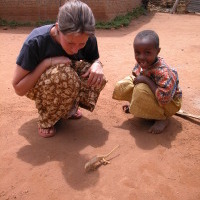








Uploads
Papers by Mario Delgado-Noguera
Por lo general no solamente en Colombia sino aun en el mundo desarrollado, se carece de una escuela formal de editores de revistas de ciencias de la salud (2). Aunque no tienen un entrenamiento formal, buena parte de ellos han sido profesores que se han formado en epidemiología, se han desempeñado como investigadores, han tenido a su cargo un grupo de investigación y han sido tutores. Un camino a veces incomprendido.
Introduction: It is necessary to know the academic production of the Facultad Ciencias de la Salud for generating processes of feed-back and institutional accreditation, this is achieved through bibliometrics. The bibliometrics uses the scientific method to quantify the academic production resultingof research process. Methods: Cross-sectional bibliometric investigation that used as population the whole scientific production represented in the published articles on journals (online and paper) in 2010 to 2016 in the Facultad de Ciencias de la Salud. Results: 183 articles were found to fulfill the inclusion criteria. The trend of the production decreasing since 2013. The departments of Medicine program were the ones with most contributions to the production (72%), followed by Fonoaudiology (10%), Physiotherapy (4%) and Nursery (2%). The main authors were men, doctors and specialists. The student’s entailment was found in 35%. Mainly, the articles were published in the Revista de la Facultad de Ciencias de la Salud (57%). The financing was observed only nly in one article. Conclusions: This study shows, for the first time, the bibliometric reality of our faculty. The university support is needed to continue with this labor that improves the planning and strengthens the academic quality.
Resumen
Introducción: Es necesario conocer la producción académica de las facultades de ciencias de la salud para los procesos de retroalimentación y acreditación de las instituciones esto se logra a través de la bibliometría. La bibliometría que en términos simples, utiliza el método científico para cuantificar la producción derivada de la investigación. Métodos: Investigación bibliométrica descriptiva de corte transversal que consideró como población toda la producción científica académica de la facultad representada en la publicación de artículos en revistas y publicaciones periódicas en el período 2010-2016. Resultados: Se encontraron 183 artículos que cumplían con los criterios de inclusión. La tendencia de producción fue decreciente desde el año 2013. Los departamentos del programa de Medicina fueron los que más aportaron a la producción (72%) seguidos por Fonoaudiología (10%), Fisioterapia (4%) y Enfermería (2%). Los autores principales más frecuentes fueron de género masculino, médicos especialistas y profesores de planta. La vinculación estudiantil fue de 35%. Principalmente se publicó en la Revista Facultad de Ciencias de la Salud (57%). La colaboración externa internacional para la publicación fue la más frecuente (38%). El financiamiento ocurrió solamente en un producto. Conclusiones: Este es un estudio que expone la realidad bibliométrica por primera vez en la Facultad Ciencias de la Salud. Es necesario el apoyo universitario en esta labor que favorece la planificación y que fortalece la calidad académica.
Delgado-Noguera MF1, Calvache JA, Bonfill Cosp X, Kotanidou EP, Galli-Tsinopoulou A.
Author information
Abstract
BACKGROUND:
Long chain polyunsaturated fatty acids (LCPUFA), especially docosahexaenoic acid (DHA), are the most abundant fatty acids in the brain and are necessary for growth and maturation of an infant's brain and retina. LCPUFAs are named "essential" because they cannot be synthesised efficiently by the human body and come from maternal diet. It remains controversial whether LCPUFA supplementation to breastfeeding mothers is beneficial for the development of their infants.
OBJECTIVES:
To assess the effectiveness and safety of supplementation with LCPUFA in breastfeeding mothers in the cognitive and physical development of their infants as well as safety for the mother and infant.
SEARCH METHODS:
We searched the Cochrane Pregnancy and Childbirth Group's Trials Register (6 August 2014), CENTRAL (Cochrane Library 2014, Issue 8), PubMed (1966 to August 2014), EMBASE (1974 to August 2014), LILACS (1982 to August 2014), Google Scholar (August 2014) and reference lists of published narrative and systematic reviews.
SELECTION CRITERIA:
Randomised controlled trials or cluster-randomised controlled trials evaluating the effects of LCPUFA supplementation on breastfeeding mothers (including the pregnancy period) and their infants.
DATA COLLECTION AND ANALYSIS:
Two review authors independently assessed eligibility and trial quality, performed data extraction and evaluated data accuracy.
MAIN RESULTS:
We included eight randomised controlled trials involving 1567 women. All the studies were performed in high-income countries. The longest follow-up was seven years.We report the results from the longest follow-up time point from included studies. Overall, there was moderate quality evidence as assessed using the GRADE approach from these studies for the following outcomes measured beyond 24 months age of children: language development and child weight. There was low-quality evidence for the outcomes: Intelligence or solving problems ability, psychomotor development, child attention, and child visual acuity.We found no significant difference in children's neurodevelopment at long-term follow-up beyond 24 months: language development (standardised mean difference (SMD) -0.27, 95% confidence interval (CI) -0.56 to 0.02; two trials, 187 participants); intelligence or problem-solving ability (three trials, 238 participants; SMD 0.00, 95% CI -0.36 to 0.36); psychomotor development (SMD -0.11, 95% CI -0.48 to 0.26; one trial, 113 participants); motor development (SMD -0.23, 95% CI -0.60 to 0.14; one trial, 115 participants), or in general movements (risk ratio, RR, 1.12, 95% CI 0.58 to 2.14; one trial, 77 participants; at 12 weeks of life). However, child attention scores were better at five years of age in the group of children whose mothers had received supplementation with fatty acids (mean difference (MD) 4.70, 95% CI 1.30 to 8.10; one study, 110 participants)). In working memory and inhibitory control, we found no significant difference (MD -0.02 95% CI -0.07 to 0.03 one trial, 63 participants); the neurological optimality score did not present any difference (P value: 0.55).For child visual acuity, there was no significant difference (SMD 0.33, 95% CI -0.04 to 0.71; one trial, 111 participants).For growth, there were no significant differences in length (MD -0.39 cm, 95% CI -1.37 to 0.60; four trials, 441 participants), weight (MD 0.13 kg, 95% CI -0.49 to 0.74; four trials, 441 participants), and head circumference (MD 0.15 cm, 95% CI -0.27 to 0.58; three trials, 298 participants). Child fat mass and fat mass distribution did not differ between the intervention and control group (MD 2.10, 95% CI -0.48 to 4.68; one trial, 115 participants, MD -0.50, 95% CI -1.69 to 0.69; one trial, 165 participants, respectively).One study (117 infants) reported a significant difference in infant allergy at short-term follow-up (risk ratio (RR) 0.13, 95% CI 0.02 to 0.95), but not at medium-term follow-up (RR 0.52, 95% CI 0.17 to 1.59).We found no significant difference in two trials evaluating postpartum depression. Data were not possible to be pooled due to differences in the describing of the outcome. One study (89 women) did not find any significant difference between the LCPUFA supplementation and the control group at four weeks postpartum (MD 1.00, 95%CI -1.72 to 3.72).No adverse effects were reported.
AUTHORS' CONCLUSIONS:
Based on the available evidence, LCPUFA supplementation did not appear to improve children's neurodevelopment, visual acuity or growth. In child attention at five years of age, weak evidence was found (one study) favouring the supplementation. Currently, there is inconclusive evidence to support or refute the practice of giving LCPUFA supplementation to breastfeeding mothers in order to improve neurodevelopment or visual acuity.
Long chain polyunsaturated fatty acids (LCPUFA), especially docosahexaenoic acid (DHA), are the most abundant fatty acids in the brain and are necessary for growth and maturation of the brain and retina. LCPUFA are named “essential” because they cannot be synthesised efficiently by the human body and come from maternal diet. It remains controversial whether LCPUFA supplementation to breastfeeding mothers is beneficial for the development of their infants.
Objectives
To assess the effectiveness and safety of supplementation with LCPUFA in breastfeeding mothers in the cognitive and physical development of their infants as well as safety for the mother and infant.
Search strategy
We searched the Cochrane Pregnancy and Childbirth Group’s Trials Register (November 2009), CENTRAL (2009, Issue 2), PubMed (1966 to July 2009), EMBASE (1974 to June 2009), CINAHL (1984 to June 2009), LILACS (1982 to June 2009), Google Scholar (June 2009) and reference lists of published narrative and systematic reviews.
Selection criteria
Randomised controlled trials or cluster-randomised controlled trials evaluating the effects of LCPUFA supplementation on breastfeeding mothers and their infants.
Data collection and analysis
Two review authors independently assessed eligibility and trial quality and performed data extraction.
Main results
We included six randomised controlled trials involving 1280women.We found no significant difference in children’s neurodevelopment: language development (standardised mean difference (SMD) -0.14, 95% confidence interval (CI) -0.49 to 0.20; two trials, 349 participants); intelligence or problem-solving ability (two trials, 817 participants; SMD -0.22, 95% CI -0.23 to 0.66); psychomotor development (SMD 0.34, 95% CI -0.11 to 0.78; two trials, 279 participants); motor development (SMD 0.08, 95% CI -0.13 to 0.29; two trials, 349 participants); in child attention there was a significant difference (SMD 0.50, 95% CI 0.24 to 0.77; one study). For child visual acuity there was no significant difference (SMD -0.06, 95% CI -0.26 to 0.14; three trials, 401 participants). For growth, there were significant differences in length (MD -0.75 cm, 95% CI -1.38 to -0.12; two trials, 834 participants) and head circumference
(MD 0.69 cm, 95% CI 0.35 to 1.02; one trial, 244 participants). One study reported a significant difference in infant allergy (risk
ratio (RR) 0.12, 95% CI 0.02 to 0.95). We found no significant difference in one trial evaluating postpartum depression (SMD 0.15, 95% CI -0.11 to 0.41).
Authors’ conclusions
Based on the limited evidence that we found, LCPUFA supplementation did not appear to improve children’s neurodevelopment or visual acuity. In two studies, LCPUFA supplementation was associatedwith increased head circumference.Currently, there is insufficient
evidence to support or refute this supplementation.
Methods: This study was retrospective description of minor and moderate burn victims admitted between 2000 and 2010 at the Burn Unit of University Hospital San Jose ́ (UHSJ). The following variables were recorded and analyzed: age, gender, origin, social security, depth and extent of burn, days of hospitalization, causal agent and mortality. SPSS 19.0 was used. The level of significance was p < 0.05.
Results: During 2000–2010, 845 patients were included. 61.7% were men. The average age was 17.9 years. Most of patients were from rural areas (80.4%). Most people belonged to the Subsidized Health Colombian System (85.3%). The most common causal agent was scalding liquids (49.7%). The most frequent depth was second degree burns (57.8%) and the average burned body surface was 20%. The average hospital stay was 20.4 days, and the median hospitalization time was 14 days. Mortality was 1.4%.
Conclusions: The findings of this study are the first to define the characteristics of burns in Popaya ́n. This study is the basis for identifying preventative measures in the local health care system.
Por lo general no solamente en Colombia sino aun en el mundo desarrollado, se carece de una escuela formal de editores de revistas de ciencias de la salud (2). Aunque no tienen un entrenamiento formal, buena parte de ellos han sido profesores que se han formado en epidemiología, se han desempeñado como investigadores, han tenido a su cargo un grupo de investigación y han sido tutores. Un camino a veces incomprendido.
Introduction: It is necessary to know the academic production of the Facultad Ciencias de la Salud for generating processes of feed-back and institutional accreditation, this is achieved through bibliometrics. The bibliometrics uses the scientific method to quantify the academic production resultingof research process. Methods: Cross-sectional bibliometric investigation that used as population the whole scientific production represented in the published articles on journals (online and paper) in 2010 to 2016 in the Facultad de Ciencias de la Salud. Results: 183 articles were found to fulfill the inclusion criteria. The trend of the production decreasing since 2013. The departments of Medicine program were the ones with most contributions to the production (72%), followed by Fonoaudiology (10%), Physiotherapy (4%) and Nursery (2%). The main authors were men, doctors and specialists. The student’s entailment was found in 35%. Mainly, the articles were published in the Revista de la Facultad de Ciencias de la Salud (57%). The financing was observed only nly in one article. Conclusions: This study shows, for the first time, the bibliometric reality of our faculty. The university support is needed to continue with this labor that improves the planning and strengthens the academic quality.
Resumen
Introducción: Es necesario conocer la producción académica de las facultades de ciencias de la salud para los procesos de retroalimentación y acreditación de las instituciones esto se logra a través de la bibliometría. La bibliometría que en términos simples, utiliza el método científico para cuantificar la producción derivada de la investigación. Métodos: Investigación bibliométrica descriptiva de corte transversal que consideró como población toda la producción científica académica de la facultad representada en la publicación de artículos en revistas y publicaciones periódicas en el período 2010-2016. Resultados: Se encontraron 183 artículos que cumplían con los criterios de inclusión. La tendencia de producción fue decreciente desde el año 2013. Los departamentos del programa de Medicina fueron los que más aportaron a la producción (72%) seguidos por Fonoaudiología (10%), Fisioterapia (4%) y Enfermería (2%). Los autores principales más frecuentes fueron de género masculino, médicos especialistas y profesores de planta. La vinculación estudiantil fue de 35%. Principalmente se publicó en la Revista Facultad de Ciencias de la Salud (57%). La colaboración externa internacional para la publicación fue la más frecuente (38%). El financiamiento ocurrió solamente en un producto. Conclusiones: Este es un estudio que expone la realidad bibliométrica por primera vez en la Facultad Ciencias de la Salud. Es necesario el apoyo universitario en esta labor que favorece la planificación y que fortalece la calidad académica.
Delgado-Noguera MF1, Calvache JA, Bonfill Cosp X, Kotanidou EP, Galli-Tsinopoulou A.
Author information
Abstract
BACKGROUND:
Long chain polyunsaturated fatty acids (LCPUFA), especially docosahexaenoic acid (DHA), are the most abundant fatty acids in the brain and are necessary for growth and maturation of an infant's brain and retina. LCPUFAs are named "essential" because they cannot be synthesised efficiently by the human body and come from maternal diet. It remains controversial whether LCPUFA supplementation to breastfeeding mothers is beneficial for the development of their infants.
OBJECTIVES:
To assess the effectiveness and safety of supplementation with LCPUFA in breastfeeding mothers in the cognitive and physical development of their infants as well as safety for the mother and infant.
SEARCH METHODS:
We searched the Cochrane Pregnancy and Childbirth Group's Trials Register (6 August 2014), CENTRAL (Cochrane Library 2014, Issue 8), PubMed (1966 to August 2014), EMBASE (1974 to August 2014), LILACS (1982 to August 2014), Google Scholar (August 2014) and reference lists of published narrative and systematic reviews.
SELECTION CRITERIA:
Randomised controlled trials or cluster-randomised controlled trials evaluating the effects of LCPUFA supplementation on breastfeeding mothers (including the pregnancy period) and their infants.
DATA COLLECTION AND ANALYSIS:
Two review authors independently assessed eligibility and trial quality, performed data extraction and evaluated data accuracy.
MAIN RESULTS:
We included eight randomised controlled trials involving 1567 women. All the studies were performed in high-income countries. The longest follow-up was seven years.We report the results from the longest follow-up time point from included studies. Overall, there was moderate quality evidence as assessed using the GRADE approach from these studies for the following outcomes measured beyond 24 months age of children: language development and child weight. There was low-quality evidence for the outcomes: Intelligence or solving problems ability, psychomotor development, child attention, and child visual acuity.We found no significant difference in children's neurodevelopment at long-term follow-up beyond 24 months: language development (standardised mean difference (SMD) -0.27, 95% confidence interval (CI) -0.56 to 0.02; two trials, 187 participants); intelligence or problem-solving ability (three trials, 238 participants; SMD 0.00, 95% CI -0.36 to 0.36); psychomotor development (SMD -0.11, 95% CI -0.48 to 0.26; one trial, 113 participants); motor development (SMD -0.23, 95% CI -0.60 to 0.14; one trial, 115 participants), or in general movements (risk ratio, RR, 1.12, 95% CI 0.58 to 2.14; one trial, 77 participants; at 12 weeks of life). However, child attention scores were better at five years of age in the group of children whose mothers had received supplementation with fatty acids (mean difference (MD) 4.70, 95% CI 1.30 to 8.10; one study, 110 participants)). In working memory and inhibitory control, we found no significant difference (MD -0.02 95% CI -0.07 to 0.03 one trial, 63 participants); the neurological optimality score did not present any difference (P value: 0.55).For child visual acuity, there was no significant difference (SMD 0.33, 95% CI -0.04 to 0.71; one trial, 111 participants).For growth, there were no significant differences in length (MD -0.39 cm, 95% CI -1.37 to 0.60; four trials, 441 participants), weight (MD 0.13 kg, 95% CI -0.49 to 0.74; four trials, 441 participants), and head circumference (MD 0.15 cm, 95% CI -0.27 to 0.58; three trials, 298 participants). Child fat mass and fat mass distribution did not differ between the intervention and control group (MD 2.10, 95% CI -0.48 to 4.68; one trial, 115 participants, MD -0.50, 95% CI -1.69 to 0.69; one trial, 165 participants, respectively).One study (117 infants) reported a significant difference in infant allergy at short-term follow-up (risk ratio (RR) 0.13, 95% CI 0.02 to 0.95), but not at medium-term follow-up (RR 0.52, 95% CI 0.17 to 1.59).We found no significant difference in two trials evaluating postpartum depression. Data were not possible to be pooled due to differences in the describing of the outcome. One study (89 women) did not find any significant difference between the LCPUFA supplementation and the control group at four weeks postpartum (MD 1.00, 95%CI -1.72 to 3.72).No adverse effects were reported.
AUTHORS' CONCLUSIONS:
Based on the available evidence, LCPUFA supplementation did not appear to improve children's neurodevelopment, visual acuity or growth. In child attention at five years of age, weak evidence was found (one study) favouring the supplementation. Currently, there is inconclusive evidence to support or refute the practice of giving LCPUFA supplementation to breastfeeding mothers in order to improve neurodevelopment or visual acuity.
Long chain polyunsaturated fatty acids (LCPUFA), especially docosahexaenoic acid (DHA), are the most abundant fatty acids in the brain and are necessary for growth and maturation of the brain and retina. LCPUFA are named “essential” because they cannot be synthesised efficiently by the human body and come from maternal diet. It remains controversial whether LCPUFA supplementation to breastfeeding mothers is beneficial for the development of their infants.
Objectives
To assess the effectiveness and safety of supplementation with LCPUFA in breastfeeding mothers in the cognitive and physical development of their infants as well as safety for the mother and infant.
Search strategy
We searched the Cochrane Pregnancy and Childbirth Group’s Trials Register (November 2009), CENTRAL (2009, Issue 2), PubMed (1966 to July 2009), EMBASE (1974 to June 2009), CINAHL (1984 to June 2009), LILACS (1982 to June 2009), Google Scholar (June 2009) and reference lists of published narrative and systematic reviews.
Selection criteria
Randomised controlled trials or cluster-randomised controlled trials evaluating the effects of LCPUFA supplementation on breastfeeding mothers and their infants.
Data collection and analysis
Two review authors independently assessed eligibility and trial quality and performed data extraction.
Main results
We included six randomised controlled trials involving 1280women.We found no significant difference in children’s neurodevelopment: language development (standardised mean difference (SMD) -0.14, 95% confidence interval (CI) -0.49 to 0.20; two trials, 349 participants); intelligence or problem-solving ability (two trials, 817 participants; SMD -0.22, 95% CI -0.23 to 0.66); psychomotor development (SMD 0.34, 95% CI -0.11 to 0.78; two trials, 279 participants); motor development (SMD 0.08, 95% CI -0.13 to 0.29; two trials, 349 participants); in child attention there was a significant difference (SMD 0.50, 95% CI 0.24 to 0.77; one study). For child visual acuity there was no significant difference (SMD -0.06, 95% CI -0.26 to 0.14; three trials, 401 participants). For growth, there were significant differences in length (MD -0.75 cm, 95% CI -1.38 to -0.12; two trials, 834 participants) and head circumference
(MD 0.69 cm, 95% CI 0.35 to 1.02; one trial, 244 participants). One study reported a significant difference in infant allergy (risk
ratio (RR) 0.12, 95% CI 0.02 to 0.95). We found no significant difference in one trial evaluating postpartum depression (SMD 0.15, 95% CI -0.11 to 0.41).
Authors’ conclusions
Based on the limited evidence that we found, LCPUFA supplementation did not appear to improve children’s neurodevelopment or visual acuity. In two studies, LCPUFA supplementation was associatedwith increased head circumference.Currently, there is insufficient
evidence to support or refute this supplementation.
Methods: This study was retrospective description of minor and moderate burn victims admitted between 2000 and 2010 at the Burn Unit of University Hospital San Jose ́ (UHSJ). The following variables were recorded and analyzed: age, gender, origin, social security, depth and extent of burn, days of hospitalization, causal agent and mortality. SPSS 19.0 was used. The level of significance was p < 0.05.
Results: During 2000–2010, 845 patients were included. 61.7% were men. The average age was 17.9 years. Most of patients were from rural areas (80.4%). Most people belonged to the Subsidized Health Colombian System (85.3%). The most common causal agent was scalding liquids (49.7%). The most frequent depth was second degree burns (57.8%) and the average burned body surface was 20%. The average hospital stay was 20.4 days, and the median hospitalization time was 14 days. Mortality was 1.4%.
Conclusions: The findings of this study are the first to define the characteristics of burns in Popaya ́n. This study is the basis for identifying preventative measures in the local health care system.